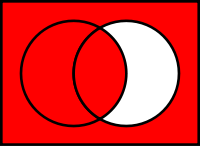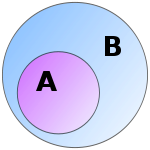
Subset
Did you know...
SOS Children produced this website for schools as well as this video website about Africa. See http://www.soschildren.org/sponsor-a-child to find out about child sponsorship.

A is a subset of B. The left circle is A, the right B. Red parts indicate possible situations. The situation in which something is inside the circle A, but not in B is not red, thus impossible.
In mathematics, especially in set theory, a set A is a subset of a set B if A is "contained" inside B. Notice that A and B may coincide. The relationship of one set being a subset of another is called inclusion or containment.
Definitions
If A and B are sets and every element of A is also an element of B, then:
-
- A is a subset of (or is included in) B, denoted by
 ,
,
- A is a subset of (or is included in) B, denoted by
- or equivalently
- B is a superset of (or includes) A, denoted by
 .
.
- B is a superset of (or includes) A, denoted by
If A is a subset of B, but A is not equal to B (i.e. there exists at least one element of B not contained in A), then
-
- A is also a proper (or strict) subset of B; this is written as
 .
.
- A is also a proper (or strict) subset of B; this is written as
- or equivalently
- B is a proper superset of A; this is written as
 .
.
- B is a proper superset of A; this is written as
For any set S, the inclusion relation ⊆ is a partial order on the set 2S of all subsets of S (the power set of S).
The symbols ⊂ and ⊃
Other authors prefer to use the symbols ⊂ and ⊃ to indicate proper subset and superset, respectively, in place of  and
and  . This usage makes ⊆ and ⊂ analogous to ≤ and < For example, if x ≤ y then x may be equal to y, or maybe not, but if x < y, then x definitely does not equal y, but is strictly less than y. Similarly, using the "⊂ means proper subset" convention, if A ⊆ B, then A may or may not be equal to B, but if A ⊂ B, then A is definitely not equal to B.
. This usage makes ⊆ and ⊂ analogous to ≤ and < For example, if x ≤ y then x may be equal to y, or maybe not, but if x < y, then x definitely does not equal y, but is strictly less than y. Similarly, using the "⊂ means proper subset" convention, if A ⊆ B, then A may or may not be equal to B, but if A ⊂ B, then A is definitely not equal to B.
Examples
- The set {1, 2} is a proper subset of {1, 2, 3}.
- Any set is a subset of itself, but not a proper subset.
- The empty set, written ∅, is also a subset of any given set X. (This statement is vacuously true, see proof below) The empty set is always a proper subset, except of itself.
- The set {x : x is a prime number greater than 2000} is a proper subset of {x : x is an odd number greater than 1000}
- The set of natural numbers is a proper subset of the set of rational numbers and the set of points in a line segment is a proper subset of the set of points in a line. These are counter-intuitive examples in which both the part and the whole are infinite, and the part has the same number of elements as the whole (see Cardinality of infinite sets).
Properties
Proposition 1
The empty set is a subset of every set.
Proof: Given any set A, we wish to prove that ø is a subset of A. This involves showing that all elements of ø are elements of A. But there are no elements of ø.
For the experienced mathematician, the inference " ø has no elements, so all elements of ø are elements of A" is immediate, but it may be more troublesome for the beginner. Since ø has no members at all, how can "they" be members of anything else? It may help to think of it the other way around. In order to prove that ø was not a subset of A, we would have to find an element of ø which was not also an element of A. Since there are no elements of ø, this is impossible and hence ø is indeed a subset of A.
Proposition 2
The following proposition says that inclusion is a partial order.
If A, B and C are sets then the following hold:
- reflexivity: A ⊆ A
- antisymmetry: A ⊆ B and B ⊆ A if and only if A = B
- transitivity: If A ⊆ B and B ⊆ C then A ⊆ C
Proposition 3
The following proposition says that for any set S the power set of S ordered by inclusion is a bounded lattice, and hence together with the distributive and complement laws for unions and intersections (see The fundamental laws of set algebra), show that it is a Boolean algebra.
If A, B and C are subsets of a set S then the following hold:
- existence of a least element and a greatest element:
-
- ø ⊆ A ⊆ S (that ø ⊆ A is Proposition 1 above.)
-
- existence of joins:
-
- A ⊆ A∪B
- If A ⊆ C and B ⊆ C then A∪B ⊆ C
-
- existence of meets:
-
- A∩B ⊆ A
- If C ⊆ A and C ⊆ B then C ⊆ A∩B
-
Proposition 4
The following proposition says that, the statement "A ⊆ B ", is equivalent to various other statements involving unions, intersections and complements.
For any two sets A and B, the following are equivalent:
-
- A ⊆ B
- A ∩ B = A
- A ∪ B = B
- A − B = ø
- B′ ⊆ A′
This shows that the relation of set inclusion can be characterized by either of the set operations of union or intersection, which means that the notion of set inclusion is axiomatically superfluous given either of those operations and equality.
Proposition 5
If the number of elements of the set A is n, then the number of all subsets of A is equal to  .
.
The proof of this is an exercise in induction.
Other properties of inclusion
Inclusion is the canonical partial order in the sense that every partially ordered set (X,  ) is isomorphic to some collection of sets ordered by inclusion. The ordinal numbers are a simple example—if each ordinal n is identified with the set [n] of all ordinals less than or equal to n, then a ≤ b if and only if [a] ⊆ [b].
) is isomorphic to some collection of sets ordered by inclusion. The ordinal numbers are a simple example—if each ordinal n is identified with the set [n] of all ordinals less than or equal to n, then a ≤ b if and only if [a] ⊆ [b].
For the power set 2S of a set S, the inclusion partial order is (up to an order isomorphism) the Cartesian product of k = |S| (the cardinality of S) copies of the partial order on {0,1} for which 0 < 1. This can be illustrated by enumerating S = {s1, s2, …, sk} and associating with each subset T ⊆ S (which is to say with each element of 2S) the k-tuple from {0,1}k of which the ith coordinate is 1 if and only if si is a member of T.


